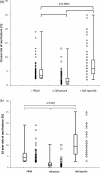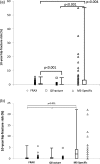Assessing fracture risk in people with MS: a service development study comparing three fracture risk scoring systems
- PMID: 23482989
- PMCID: PMC3612805
- DOI: 10.1136/bmjopen-2012-002508
Assessing fracture risk in people with MS: a service development study comparing three fracture risk scoring systems
Abstract
Objectives: Suboptimal bone health is increasingly recognised as an important cause of morbidity. Multiple sclerosis (MS) has been consistently associated with an increased risk of osteoporosis and fracture. Various fracture risk screening tools have been developed, two of which are in routine use and a further one is MS-specific. We set out to compare the results obtained by these in the MS clinic population.
Design: This was a service development study. The 10-year risk estimates of any fracture and hip fracture generated by each of the algorithms were compared.
Setting: The MS clinic at the Royal London Hospital.
Participants: 88 patients with a confirmed diagnosis of MS.
Outcome measures: Mean 10-year overall fracture risk and hip fracture risk were calculated using each of the three fracture risk calculators. The number of interventions that would be required as a result of using each of these tools was also compared.
Results: Mean 10-year fracture risk was 4.7%, 2.3% and 7.6% using FRAX, QFracture and the MS-specific calculator, respectively (p<0.0001 for difference). The agreement between risk scoring tools was poor at all levels of fracture risk.
Conclusions: The agreement between these three fracture risk scoring tools is poor in the MS population. Further work is required to develop and validate an accurate fracture risk scoring system for use in MS.
Trial registration: This service development study was approved by the Clinical Effectiveness Department at Barts Health NHS Trust (project registration number 156/12).
Figures



Similar articles
-
Predicting fracture risk in osteoporosis: the use of fracture prediction tools in an osteoporosis clinic population.Postgrad Med J. 2016 May;92(1087):267-70. doi: 10.1136/postgradmedj-2015-133454. Epub 2016 Jan 20. Postgrad Med J. 2016. PMID: 26792635
-
External validation and comparison of three prediction tools for risk of osteoporotic fractures using data from population based electronic health records: retrospective cohort study.BMJ. 2017 Jan 19;356:i6755. doi: 10.1136/bmj.i6755. BMJ. 2017. PMID: 28104610 Free PMC article.
-
Worldwide Fracture Prediction.J Clin Densitom. 2017 Jul-Sep;20(3):397-424. doi: 10.1016/j.jocd.2017.06.008. Epub 2017 Jul 19. J Clin Densitom. 2017. PMID: 28734709 Review.
-
clinical risk factors for osteoporosis in Ireland and the UK: a comparison of FRAX and QFractureScores.Calcif Tissue Int. 2011 Aug;89(2):172-7. doi: 10.1007/s00223-011-9504-2. Epub 2011 Jun 7. Calcif Tissue Int. 2011. PMID: 21647704
-
Performance of predictive tools to identify individuals at risk of non-traumatic fracture: a systematic review, meta-analysis, and meta-regression.Osteoporos Int. 2019 Apr;30(4):721-740. doi: 10.1007/s00198-019-04919-6. Epub 2019 Mar 14. Osteoporos Int. 2019. PMID: 30877348
Cited by
-
Are we responding effectively to bone mineral density loss and fracture risks in people with epilepsy?Epilepsia Open. 2020 Apr 14;5(2):240-247. doi: 10.1002/epi4.12392. eCollection 2020 Jun. Epilepsia Open. 2020. PMID: 32524049 Free PMC article.
-
Comparison of fracture risk calculators in elderly fallers: a hospital-based cross-sectional study.BMJ Open. 2022 Jul 12;12(7):e060282. doi: 10.1136/bmjopen-2021-060282. BMJ Open. 2022. PMID: 35820750 Free PMC article.
-
Novel assessment tools for osteoporosis diagnosis and treatment.Curr Osteoporos Rep. 2014 Sep;12(3):357-65. doi: 10.1007/s11914-014-0215-2. Curr Osteoporos Rep. 2014. PMID: 24879507 Free PMC article. Review.
-
A service development study of the assessment and management of fracture risk in Parkinson's disease.J Neurol. 2014 Jun;261(6):1153-9. doi: 10.1007/s00415-014-7333-8. Epub 2014 Apr 10. J Neurol. 2014. PMID: 24718980 Free PMC article.
-
Risk Factors, Epidemiology and Treatment Strategies for Metabolic Bone Disease in Patients with Neurological Disease.Curr Osteoporos Rep. 2016 Oct;14(5):199-210. doi: 10.1007/s11914-016-0320-5. Curr Osteoporos Rep. 2016. PMID: 27525980 Review.
References
-
- http://guidance.nice.org.uk/CG/Wave25/2 (accessed 1 Nov 2012)
-
- Hippisley-Cox J, Coupland C. Derivation and validation of updated QFracture algorithm to predict risk of osteoporotic fracture in primary care in the United Kingdom: prospective open cohort study. BMJ 2012;344:e3427. - PubMed
-
- Dobson R, Ramagopalan S, Giovannoni G. Bone health and multiple sclerosis. Mult Scler 2012;18:1522–8 - PubMed
LinkOut - more resources
Full Text Sources
Other Literature Sources
Molecular Biology Databases
